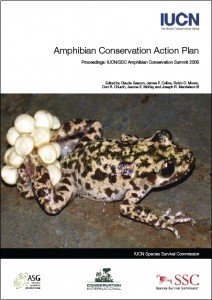Zoos and aquariums around the world have already accomplished some great work in amphibian conservation. But the time for status quo is far behind us: we must change our view and approach to amphibian conservation now. We are no longer talking about an amphibian population decline phenomenon, we are speaking of an amphibian species extinction crisis. 43% of amphibian species are experiencing decline, 32% are globally threatened, more than 120 species are possibly extinct, at least one family (with a unique reproductive mode) has been lost.
We are on the verge of losing a huge part of an entire vertebrate class, one more speciose than the mammals that are currently consuming the lion’s share of our resources. This epiphany comes with a charge – any organization that considers conservation a core goal must take immediate measures for significant action! Our response now must be in proportion to the crisis, lest we relegate ourselves to mere entertainment venues with no facade of conservation, as our critics have long accused. Not only are we uniquely qualified for the task, the rest of the conservation and scientific community is expecting us to respond.
“Current data indicate that the general trend of amphibian extinctions is accelerating at an unprecedented rate and future catastrophic loses are inevitable. Within this context, the AZA Amphibian Taxon Advisory Group’s Regional Collection Plan (RCP) reflects a more tightly defined scope for suggested amphibian programs in AZA institutions that will enable colleagues to utilize their resources to their fullest potential and respond in chorus with the rest of the global amphibian community. While using the RCP to develop institutional collection plans and conservation programs, keep in mind that resources are limited and space is at a premium for managed programs. Never before has the zoological community been tasked with the conservation of so many species at such a rapid pace. The global amphibian crisis has been and will continue to be a challenge for us all, but we must remain optimistic, as we know AZA institutions are up to the task. Please help conserve these unique and important creatures by following the recommendations of this RCP to expand space and develop new amphibian programs and strategies through collaborative partnerships.” – Association of Zoos & Aquariums Amphibian Taxon Advisory Group’s Regional Collection Plan, 3rd edition, June 2014.
 Download the Amphibian Conservation Action Plan (ACAP)
Download the Amphibian Conservation Action Plan (ACAP)
Proceedings: IUCN/SSC Amphibian Conservation Summit 2005
A guide to husbandry and biosecurity standards required for the safe and responsible management of ex situ populations of amphibians – These standards are based upon those reported in the proceedings of the CBSG/WAZA Amphibian Ex situ Conservation Planning Workshop, El Valle, Panama, 12-15th February 2006.
References:
2019 Amphibian Survival Alliance (ASA): “The needs of amphibians are no different from our own, so the issues they face ─ such as inadequate freshwater management, habitat destruction, climate change, pollution, unregulated use and trade of species, disease dynamics in a shifting world, invasive species, and the unsustainable exploitation of natural resources ─ are extremely pertinent to us, and to all species. These issues, both separately and together, demand the development of collaborative solutions to improve the management of our one and only Earth.” www.amphibians.org/who-we-are/why-amphibians/
2007 IUCN ACAP: “The only hope for populations and species at immediate risk of extinction is immediate rescue for the establishment and management of captive survival-assurance colonies.”
2005 IUCN ACAP White Papers: “Survival assurance colonies are mandatory for amphibian species that will not persist in the wild long enough to recover naturally once environments are restored; these species need to be saved now through ex-situ measures so that more complete restoration of ecosystems is possible in the future.”
2005 IUCN ACS Declaration: “The ACAP recommends prioritized … captive survival assurance programs … to buy time for species that would otherwise become extinct…”
2002 IUCN Technical Guidelines on the Management of Ex-situ populations for Conservation: “All Critically Endangered and Extinct in the Wild taxa should be subject to ex situ management to ensure recovery of wild populations.”













